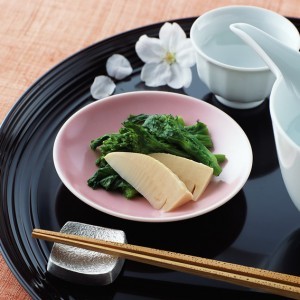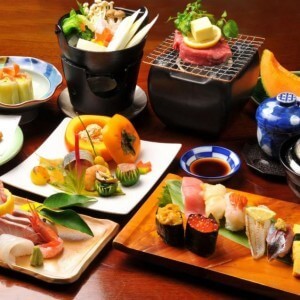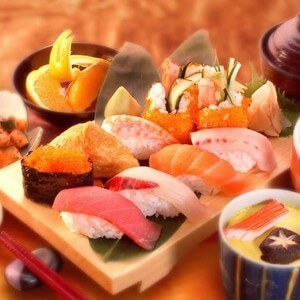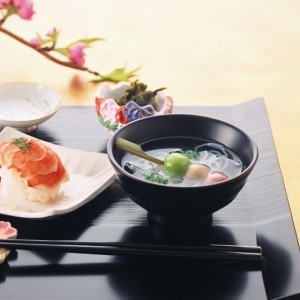
The Japanese diet is a low-carbohydrate and low-calorie diet developed by Japanese nutritionists, whose protein menu allows you to lose about 10 pounds in 2 weeks.
Nowadays, overweight people call paying for an incredibly fast lifestyle. We are in a hurry to live, we are in a hurry to work, we are in a hurry to eat. . . Moreover, we often eat on the run and with what, as they say, God will send. And in the 21st century, God is increasingly sending us burgers, hot dogs, cheeseburgers and soda. . . "What to do? Don't waste precious minutes for lunch at a restaurant or what? - to cook alone in the kitchen when the business is on fire? Here, they say, the whole successful world lives like this and nothing. "This excuse is used by a large number of people leading an active lifestyle. And when your favorite jeans do not fit, when you need to buy a longer belt, when between a seductive skirt that fits snugly around the waist and ugly shapeless style with elastic, we choose the second, then, of course, it's time to come up with a new excuse. Well, in fact - all this, of course, is not the result of improper nutrition, but simply . . . thick bone. Yes, yes, and nothingit can be done on this issue, thick bone - it's so, very insidious. And as soon as it starts to grow - everything, it is impossible to stop it.
Let us now turn our attention to Japan, a country with enormous opportunities, the highest level of technological development and an incredible pace of life. It seems that if someone does not have time to take a break for proper nutrition, it is the same as the Japanese. But, surprisingly, you rarely see "thick bones" among the people of Japan. . . So what's the secret then?
The fact is that Japanese snacks are a low-calorie food, rich in protein, almost devoid of fat and "bad" carbohydrates. And the basic principle of the Eastern food tradition is moderation. That is why Japanese cuisine is called one of the healthiest foods for the body.
Taking into account the peculiarities of the Eastern tradition of eating, a balanced and extremely effective diet called Japanese was created. In fact, the menu of this diet has virtually no food from traditional Japanese cuisine. But there is also the combination of proteins, fats and carbohydrates, in the amount needed by the body to get everything it needs, without provoking, at the same time, "thickening" of the bone. There are several diet options, but the most popular is the Japanese salt-free diet for 14 days. Two weeks of proper "Japanese" nutrition will help the "thick bones" to lose more than 10 pounds and effortlessly maintain the result for several years.
The essence of the Japanese diet
Those who decide to go "Japanese" will have to be patient and move away from their usual diet for two weeks. For many, dieting may seem like a daunting challenge, but the effect will not be long in coming. But the amazing results will remain for several years. Only a two-week regimen of the "Japanese" - and ten pounds (sometimes even more - it all depends on the initial weight), anyway.
So what's the main secret? Why is the Japanese diet for one week better than other food systems for weight loss? How wonderful is losing weight even for those who have tried many other diets on themselves without success?
Everything is in carefully selected products for the diet menu - they are combined in such a way as to speed up the metabolic process as much as possible. That is why it is so important to strictly follow all the instructions, to eat only what is indicated, and not to "improve" his other products, even if at first glance it seems that they are completely interchangeable. It is also not recommended to change the days of the menu.
For many women, the level of her "hunger" is important when choosing a diet, as not everyone is able to fight the will of the samurai against their own desires, especially the old instinct of all living beings - hunger. That is why the fact that the two-week Japanese diet without salt is not a "hungry" diet. Adhering to it, you will not have to chew a cabbage for weeks and drink low-fat kefir, cursing yourself, your excess weight and those who have invented a diet. The Japanese menu contains space for interesting and delicious recipes. This diet will appeal especially to those whose breakfast usually consists only of coffee. And meat and fish lovers will not see anything difficult in it. This is the best diet for them.
The essence of the Japanese diet is easy to explain in just two words - slowness and efficiency.
"Japanese" is a low-calorie diet with protein and fiber. Carbohydrates, reduced to a minimum in the daily diet, force you to lose weight faster - when you need energy, the body begins to process its own fat reserves into joules. But it is important to remember something else: the diet of a Japanese woman will not allow the saturation of the body with the full range of vitamins and minerals. Therefore, it is strictly forbidden to go on a diet longer than prescribed (no more than 14 days) in order not to complete the weight loss course in a hospital bed.
And if you want to feel like a real Japanese, you can try Japanese sticks instead of traditional European forks and spoons. They will not only convey the fairytale spirit of the Land of the Rising Sun, but will also learn how to eat slowly and in small pieces. By the way, this trick is known to many dieters. A relaxed diet can deceive the body and make you feel full even after very small meals. This should actually be taught by the Japanese diet for weight loss.

Types of Japanese diet
The huge popularity of the Japanese diet among women around the world has led to several opportunities for this weight loss system. In particular, diet variants are known:
- Japanese diet without salt for 7 days;
- for 13 days (most commonly used diet);
- for 14 days (differs from the previous 13-day diet by only one day);
- Japanese woman with green tea; Naomi Moriyama's diet.
Proponents of each of these techniques call their favorite version "real" Japanese. Moreover, many mines are already broken in disputes over the authorship of the diet. Some claim that Japanese nutritionists invented it, others claim that this system has nothing to do with the East. Whoever is the author of the Japanese diet, the main thing is that it works. And its effectiveness has been tested by millions of donuts around the planet.
The menu of the Japanese diet for weight loss consists of foods with a minimum of calories, carbohydrates and without salt, spices, sugar and confectionery, as well as any alcohol, which is why the diet is considered strict. This contributes to the rapid breakdown of fat into body fat, as the body finds itself in a stressful situation and is forced to burn its own fat and calories.
Diet menu for 7 days
The 7-day Japanese diet is at the same time a light version of the traditional Japanese diet, but at the same time the 7-day diet is the basis of the whole diet.

Predicted results: 3-5 kilograms remain in the past.
Disadvantage: the longevity of the result is not guaranteed, as the body has not yet had time to adapt to the new metabolic system.
Day 1
Caloric content in the daily diet: 700 kcal.
Required products:
- black coffee;
- chicken eggs;
- fresh cabbage (Chinese cabbage / white cabbage);
- tomato juice (ideally freshly squeezed);
- low-fat fish.
Breakfast:
- black coffee - it is better to give preference to espresso, but it is better to forget about sugar.
Lunch:
- boiled chicken eggs (2 pieces are possible);
- "Japanese" salad - fresh cabbage and a little vegetable oil, no need to add salt;
- glass of tomato juice.
Dinner:
- steamed fish - hake, cod, mint are ideal (portion no more than 200 grams);
- Japanese salad.
Day 2
Caloric content in the daily diet: 1000 kcal.
Required products:
- coffee;
- rusks;
- fish (fatty varieties);
- cabbage;
- vegetable oil;
- beef;
- kefir.
Breakfast:
- coffee;
- rusks - take a small, weighing about 30 grams.
Lunch:
- fish, fried or stewed - for variety and additional consumption of fatty acids is better to give preference to catfish, salmon, black flounder. In total, not more than 150 grams;
- "Japanese" salad.
Dinner:
- beef - boil about 200 grams. Consume without salt;
- kefir - you can degrease, but not more than 200 grams.
Day 3
Caloric content in the daily diet: 1000 kcal.
Required products:
- coffee;
- zucchini;
- apple;
- chicken eggs;
- veal;
- cabbage;
- vegetable oil.
Breakfast:
- black coffee - don't forget about the sugar moratorium.
Lunch:
- zucchini (large enough) or parsnip root (also large) - brown in vegetable oil (do not use flour or dough for frying, salt is also prohibited);
- apple - do not get carried away, it is advisable to limit yourself to one fruit.
Dinner:
- boiled chicken eggs - 2 pieces;
- boiled beef - limit your appetite to a piece of 200 grams, prepared in a salt-free manner;
- "Japanese" salad.
Day 4
Caloric content in the daily diet: 1000 kcal.
Required products:
- coffee;
- carrots;
- hard cheese;
- chicken egg;
- apples.
Breakfast:
- black coffee without sugar.
Lunch:
- carrots - cook, it is allowed to take 3 larger roots;
- little cheese - choose from hard varieties, limit yourself to 20 grams;
- raw chicken egg - one is enough.
All the ingredients of the 4-day lunch, if you wish, can be combined in one dish - salad.
Dinner:
- apples - several fruits are allowed.
At this point, the feeling of hunger will no longer be as strong as before. Fullness comes after small portions of food.
Day 5
Caloric content in the daily diet: 800-1000 kcal.
Required products:
- carrots;
- lemon juice;
- sea fish;
- juice;
- fruit.
Breakfast:
- carrots and lemon juice - grate the vegetables and season with juice. You cannot add sugar. Also excluded on this day from breakfast and coffee.
Lunch:
- fried fish - take about 350-400 grams, variety - each from the sea;
- tomato juice - for diet it would be better to use fresh, prepared yourself. Volume - no more than 200 grams.
Dinner:
- fruit - but in no case should you consume, especially at bedtime, grapes of any variety or bananas. They will cross out all the results achieved so far.
Day 6
Caloric content in the daily diet: 900-1100 kcal.
Required products:
- coffee;
- chicken fillet;
- raw cabbage;
- carrots;
- vegetable oil;
- chicken eggs.
Breakfast:
- black coffee without sugar.
Lunch:
- chicken fillet - limit the portion to 500 g, take skinless meat. Boil in water without adding salt;
- salad - on this day a traditional "Japanese" salad can be enhanced by adding grated raw carrots.
Dinner:
- chicken eggs - boil 2 pieces;
- carrots (you can take a large one) - grate raw vegetables, season the salad with a small amount of vegetable oil (maybe olive oil).
Day 7
Caloric content in the daily diet: 700-800 kcal.
Required products:
- tea;
- fruits;
- beef;
- eggs;
- cabbage;
- vegetable oil.
Breakfast:
- tea - it is advisable to choose good varieties of green, rich in useful antioxidants.
Lunch:
- beef - boil about 200 grams. Do not use salt or other spices during cooking;
- fruit - on the last day of the diet you can pamper yourself with a lunch dessert. But do not forget about the ban on the use of bananas and grapes.
Dinner:
On this dinner day, as an endurance reward, you can choose any dinner option from the previous days. For example, choose a variant of a salad of beef, eggs and cabbage, seasoned with olive oil.
This will end the diet for some. For those who have chosen the longer versions of the Japanese, the 7th day is just the equator of work to change yourself.
For those who are not used to eating by counting calories, the "Japanese" at first may seem like a very difficult option for weight loss. But the discomfort will be noticeable only in the first few days - then the body adapts to small portions of food, begins to eat faster. After 5 days of a new diet in the body, the first stage of restructuring begins to accelerate metabolism - the main purpose of any diet is to lose weight, excess fluid is removed, the swelling disappears. To achieve the best result parallel diet you can take a course of anti-cellulite massage.
Japanese diet for 13 days
The 13-day Japanese diet is the most popular. This version is considered a complete weight loss course.
Expected results. If you are ashamed to follow all the prescriptions, at the end of the 13-day day you will lose approximately 10 kilograms and about 30 cm in volume (sometimes more).
How is it different from the 7-day option? In fact, this is a continuation of the light version of the "Japanese". That is, you will have to go through 7 days of "Japanese" life and start again on the 8th day, repeating days from the first to the sixth.

Japanese diet for 14 days
The basis for the 14-day version of the Japanese diet was the 7-day menu, albeit with some nuances. The main difference from the previous two options is that in the first week you should strictly adhere to the 7-day menu, and in the second week to eat the same program, but in reverse order. This means that the diet on the eighth day will correspond to the diet on the last day of the 7th day, on the ninth day - the menu on the 6th day, on the tenth - the menu on the 5th day. . . And according to this principle, continue until the end of the second week. As a result, complete the last 14 days of the diet with the diet from the first day of the 7-day version of the "Japanese".
Starting from the 8th day of the diet, the body activates the detoxification process and thanks to the salt-free principle of nutrition at the intercellular level, excess fluid is removed, completely eliminating the swelling. It is important that the body is in the second week of the diet accustomed to the new rate of metabolism. Thanks to this, even after switching to a normal diet (normal - this does not mean eating again in a basin for the upcoming sleep, but also do not need to live in a mode of "starvation"), the body will not gain weight, on the contrary - fatwill burn as fast as during the diet. This wonderful effect will last for about 2 years. But provided that the diet is maintained properly. Those who have already experienced the work of the "Japanese" claim that for a year after the completion of the diet, the weight continues to adjust downward. If you repeat the "Japanese" again (but not earlier than six months after the first course), then in a year, virtually effortlessly, it is possible to get rid of 20 kg of excess weight.Diet and salt
Have you ever wondered why almost any more or less effective diet includes a taboo on salt? The thing is that according to experts
1 gram of salt retains a liter of fluid in the body.
And that's nothing more than another pound to being overweight. In addition to false overweight, because thanks to salt, weight is gained not because of the fat layer, but because of fluid retention, excessive consumption of salinity provokes other problems for people. Even a few days of salt-free meals can lower blood cholesterol levels and improve the condition of blood vessels.
Of course, it is impossible to completely eliminate salt from consumption and this cannot be done. But the menu of the "Japanese" contains products that already contain a certain amount of salt - enough for the normal functioning of the organs. In particular, organic salt is found in some vegetables, fish, meat. It is impossible to eat canned vegetables, smoked meats, semi-finished products during the diet - they all have a fairly large amount of table salt in their composition.
Green tea
In addition to the classic version of the Japanese diet, there is an option in the menu, which instead of coffee is recommended to use green tea. Many nutritionists consider this variation of the "Japanese" to be more beneficial to the body.
Given that the Japanese diet is based on a protein diet, it is important that green tea (especially its Japanese form) contains huge reserves of protein and in its nutritional value this drink is not inferior to legumes.
The second plus in favor of green tea is the presence in the composition of antioxidants that protect the body from toxins and promote the elimination of toxins.
Third, and perhaps most importantly for those who lose weight, the unique chemical composition of green tea helps speed up metabolism by 4 percent (60 calories are burned per day more than without green tea).
The Japanese diet with green tea lasts 2 weeks. The components are practically the same as in the classic version of "Japanese", although there are still some excellent features.

Detailed menu for Japanese diet with green tea
Day 1 / Day 14
Breakfast:
- green tea - cup;
- cottage cheese without fat - 150 g
Lunch:
- cabbage, stewed with oil - 300 g;
- boiled chicken eggs - 2 pcs. ;
- fresh apple - a glass.
Dinner:
- vegetables in salad or steamed;
- boiled or steamed fish - 200 g
Day 2 / Day 13
Breakfast:
- green tea - cup;
- hard cheese - 2 pieces;
- toast or diet biscuits.
Lunch:
- boiled or raw cabbage seasoned with oil;
- boiled fish;
- green tea - a cup.
Dinner:
- vegetable salad;
- boiled beef - 300 g;
- boiled chicken egg - 2 pcs. ;
- Japanese green tea - a cup.
Day 3 / Day 12
Breakfast:
- Japanese green tea - cup;
- diet cookies.
Lunch:
- boiled zucchini / cauliflower;
- apple - 1 pc. ;
- green tea - a cup.
Dinner:
- yellow-green vegetable salad;
- boiled beef;
- boiled chicken eggs - 2 pcs.
Day 4 / Day 11
Breakfast:
- Japanese green tea - cup;
- cottage cheese without fat - 150 g
Lunch:
- raw grated carrots with olive oil;
- chicken egg;
- green tea without sugar.
Dinner:
- green tea;
- fruits (not grapes and bananas).
Day 5 / Day 10
Breakfast:
- green tea - cup;
- croutons with jam - 2 pcs.
Lunch:
- boiled fish - 200 g;
- tomato juice - a glass.
Dinner:
- green vegetable salad;
- hard cheese - 2 pieces;
- green tea - a cup.
Day 6 / Day 9
Breakfast:
- croutons of rye flour - 2 pcs. ;
- Japanese green tea - a cup.
Lunch:
- raw cabbage / cooked with olive oil;
- boiled chicken without skin - 400 g;
- Japanese tea - a cup.
Dinner:
- carrots (cooked / raw);
- boiled eggs - 2 pcs. ;
- unsweetened green tea.
Day 7 / Day 8
Breakfast:
- Japanese tea - cup;
- cheese (each of the hard varieties) - 2 small pieces.
Lunch:
- boiled beef - 200 g;
- cooked / stewed vegetables;
- green tea without sugar - glass.
Dinner:
- fruits - all kinds;
- Japanese green tea - a cup.
The effectiveness of this version of the Japanese diet is enhanced by the addition of green tea to the diet, and the variety and taste of the menu makes it easier to withstand the period of dietary restrictions. Repeat the diet - not earlier than a year later. So, achieved in two weeks, the results remained longer, in the future it is advisable to adhere to a healthy lifestyle, eliminate tobacco and limit alcohol portions and follow a proper diet in everyday life.

Main Dishes
Whatever Japanese diet you choose, each will have a traditional cabbage salad and cooked meat. These dishes can be prepared in different ways. But remember that they are part of the diet and the cooking process is a little different from cooking. ordinary dishes.
Preparing the right Japanese salad:
- Take raw or lightly cooked cabbage (usually cabbage or Chinese cabbage).
- Finely chop.
- Easily squeeze out excess moisture.
- Season the prepared salad base with olive or sesame oil.
- Stir and allow to simmer.
Dietary cooked meat
- Prepare meat. If it is chicken, remove the skin. Peel the veal or veal from the film.
- Rinse thoroughly with cold water.
- Put the meat in a saucepan, pour very cold water.
- After boiling, drain the water, rinse the meat and again, filling with water, put on fire.
- Cook until soft, without adding spices.
Tip: add onions, a small carrot and some greens to the water to improve the taste during cooking. Many people wonder how to replace beef in the Japanese diet. It is permissible to introduce young beef into the menu, which is easier to digest, but with the same chemical composition as beef.
How were the products selected?
Almost all sources say that the list of foods allowed during the Japanese diet is special and should not be changed. So what is the secret of this particular diet?

Cafe. Many people start their day with this aromatic drink. A cup of ground black coffee serves as a traditional breakfast in the Japanese diet.
What's the use?
Sugar-free black coffee, which has an invigorating effect, helps the body wake up faster and start the process of burning calories. And because food intake is not provided by the diet in the morning, the body begins to produce energy by burning its own reserves - subcutaneous fat.
You can diversify the taste of your morning drink by adding vanilla, dark chocolate or citrus fruits. Add additional ingredients in small doses.
Cabbage. This vegetable for the diet was not chosen by chance. In addition, cabbage is one of the vegetables with the so-called caloric content "minus" (the body expends more energy for digestion than it receives).
What's the use?
Cabbage, white or Chinese cabbage, has a strengthening effect on the walls of blood vessels, lowers cholesterol levels and cleanses the intestines. For people prone to bloating, it is better to boil the cabbage shortly before use.
Olive oil. A teaspoon of oil added to the salad, normalizes metabolism, has a beneficial effect on the liver, kidneys and pancreas.
Eggs. This product has good nutritional properties and is an excellent source of protein, fat and carbohydrates, as well as many vitamins and minerals.
Tomato juice. Nutritionists call it one of the healthiest. The unique chemical composition of tomatoes prevents cardiovascular and oncological diseases, accelerates metabolic processes in the body, improves mood and has a beneficial effect on the nervous system. It is best absorbed without the addition of salt, which is especially important for a salt-free diet.
Fish. Known for its ability to quickly remove toxins and toxins. It is a valuable source of protein and amino acids. It affects the body as a preventive measure against strokes.
Fruits. Usually during the diet the amount of carbohydrates consumed should be drastically reduced. But it is completely undesirable to exclude from the diet - they are an important source of energy. The body receives the "right" carbohydrates along with the fruit. But it is better to exclude from the diet bananas and grapes, which contain a lot of sugar.

Naomi Moriyama's Diet
It's hard not to believe in the effectiveness of the Japanese diet, especially for those who have nevertheless decided to try it on themselves. But sooner or later, many people wonder: why is this diet called the "Japanese diet" if there is virtually nothing on the menu? from traditional dishes for the Land of the Rising Sun. But there is an explanation for this. According to one version, this original diet was developed by nutritionists from the Japanese clinic "Yaelo".
But there is another version of "Japanese" created by marketer Naomi Moriyama - in response to Frenchwoman Mireille Gilliano, author of Why French Women Don't Get Fat. In fact, according to research, the French are not the thinnest in the world at all. The least obese people live in Japan - only 3 percent, while in France there are about 11% donuts, and in the United States - more than 32%. So Naomi gathered the nutritional principles that are typical of her people and adapted them to the diet.
Rules for eating from the Land of the Rising Sun
Orientals eat nearly 100 different foods a week, with a total caloric content more than a quarter lower than, say, the weekly calorie intake of Americans. And the only secret of Japanese harmony lies in a simple rule: fill your stomach 80 percent.













































































